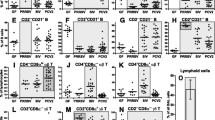Abstract
Immune serum injected into the peritoneum of rats passively protected them againstAngiostrongylus cantonensis; this protection was greater than that conferred by passively transferred immune lymph node cells. When immune lymph node cells and serum were transferred together into the same rat, no enhanced protection was observed. The protective effect of serum was inhibited by the lymph node cells to levels commensurate with those conferred by immune lymph node cells alone. Normal lymph node cells also depressed the levels of immunity conferred by immune serum when they were transferred together with serum, but to a lesser extent than did sensitized lymph node cells. Transferred antibody acted to suppress antibody production againstA. cantonensis in recipient rats.
Similar content being viewed by others
References
Bhaibulaya M (1975) Comparative studies on the life history ofAngiostrongylus mackerasae Bhaibulaya, 1968 andAngiostrongylus cantonensis (Chen, 1935). Int J Parasitol 5:7–20
Bloom BR (1979) Games parasites play: how parasites evade immune surveillance. Nature 279:21–26
Cypess R (1970) Demonstration of immunity toNematospiroides dubius in recipient mice given spleen cells. J Parasitol 56:199–200
Dobson C (1982) Passive transfer of immunity with serum in mice infected withNematospiroides dubius: influence of quality and quantity of immune serum. Int J Parasitol 12:207–213
Dobson C, Cayzer CJR (1982) Passive transfer of immunity with serum in mice infected withNematospiroides dubius: in vitro effect of immune serum on larval infectivity. Int J Parasitol (In print)
Dobson C, Owen ME (1978) Effect of host sex on passive immunity in mice infected withNematospiroides dubius. Int. J Parasitol 8:359–364
Hamaoka T, Takatsu K, Masaki H, Matsuoka Y, Kitagawa M (1971) Antibody production in mice. III. The suppressive effect of antibody on the initiation of secondary immune response. Immunology 20:871–881
Heyneman D, Lim BL (1965) Prolonged survival in rats immunized by a small number of low-level doses ofAngiostrongylus cantonensis and challenged with a lethal level of infective larvae. Med J Malaysia 20:162–163
Kamiya M (1970) Haemagglutination test in rats infected withAngiostrongylus cantonensis. SE Asian J Trop Med Publ Hlth 1:570–571
Love RJ (1975)Nippostrongylus brasiliensis infections in rats: both antibodies and sensitized cells are necessary for the immunological control of developing larvae. Int Arch Allergy Appl Immunol 48:211–219
Möller G, Wigzell H (1965) Antibody synthesis at the cellular level: antibody-induced suppression of 19S and 17S antibody response. J Exp Med 121:969–989
Ogilvie BM, Wilson RJM (1976) Evasion of the immune response by parasites. Br Med Bull 32:177–181
Rothwell TLW, Adams DB, Love RJ, Love DN, McLaren DJ (1980) Immunity againstTrichostrongylus colubriformis infection in guinea pigs and sheep: some camparisons withNippostrongylus brasiliensis infection in the rat. Int J Parasitol 10:43–49
Rowley DA, Fitch FW (1964) Homeotasis of antibody formation in the adult rat. J Exp Med 120:987–1005
Snedecor GW, Cochran WG (1967) Statistical Methods. The Iowa State University Press, Ames Iowa, pp 593
Uhr JW, Möller G (1968) Regulatory effect of antibody on the immune response. Adv Immunol 8:81–127
Yong WK, Dobson C (1982a) Antibody responses in rats infected withAngiostrongylus cantonensis and the passive transfer of protective immunity with immune serum. Z Parasitenkd (In print)
Yong WK, Dobson C (1982b) The passive transfer of protective immunity againstAngiostrongylus cantonensis with immune lymphocytes from different lymphoid tissues in rats. Int J Parasitol (In print)
Yong WK, Dobson C (1982c) Population dynamics ofAngiostrongylus cantonensis during primary infections in rats. Parasitology (In print)
Yong WK, Dobson C (1982d) The role of the spleen in protective immunity againstAngiostrongylus cantonensis in rats: splenectomy and passive spleen cell transfers. Parasite Immunol (submitted for publication)
Yong WK, Dobson C (1982e) Immunological regulation ofAngiostrongylus cantonensis infections in rats: Modulation of population density and enhanced parasite growth following multiple concurrent infection. J Helminth (submitted for publication)
Yoshimura K, Soulsby EJL (1976)Angiostrongylus cantonensis: Lymphoid cell responsiveness and antibody production in rats. Am J Trop Med Hyg 25:99–107
Author information
Authors and Affiliations
Rights and permissions
About this article
Cite this article
Yong, W.K., Dobson, C. Passive immunity in rats infected withAngiostrongylus cantonensis: Interactions between syngeneic immune serum and sensitized lymph node cells. Z. Parasitenkd. 68, 87–92 (1982). https://doi.org/10.1007/BF00926661
Accepted:
Issue Date:
DOI: https://doi.org/10.1007/BF00926661



